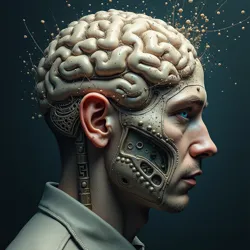The Chronosynclastron Effect

Visualizing subjective temporal distortion and altered recall of past events, depicting moments feeling unnaturally stretched, compressed, or out of sequence.
Perceptual or cognitive anomaly
Subjective temporal distortion
Altered recall of past events
Temporal shimmer, memory echo
Difficult, elusive
Individual and group experiences
Cognitive, temporal field, environmental
Reported throughout history
The *Chronosynclastron Effect* is a theorized phenomenon involving Subjective Temporal Distortion and Altered Recall of Past Events. Unlike hypothetical physical time displacement or manipulation, this effect is understood primarily as a perceptual or cognitive anomaly, manifesting as a profound and often disorienting alteration in an individual's or group's subjective experience of time and memory. It is frequently described by those who report experiencing it as a "Temporal Shimmer," a "Memory Echo," or a sense of moments feeling unnaturally stretched, compressed, or out of their proper sequence. The effect is elusive, difficult to study objectively, and remains a subject of intense, often controversial, investigation within fields ranging from cognitive science to speculative temporal physics. Its nature challenges conventional understandings of memory formation, the linear progression of time as perceived by the consciousness, and the reliability of personal or collective historical accounts.
The phenomenon is characterized by a disjunction between the objectively measurable passage of time and an individual's internal sense of duration and event ordering. People reporting the Chronosynclastron Effect often describe a feeling that recent events are somehow layered or superimposed upon one another, or that specific moments seem to repeat or linger beyond their actual occurrence. This subjective experience can be deeply unsettling, leading to confusion, disorientation, and a questioning of one's own sanity or the stability of reality itself. The effect is not universally experienced and appears to be unpredictable in its onset and duration, adding to the difficulty of systematic study. It is often discussed in conjunction with studies on the malleability of memory and the complex processes underlying time perception. [https://en.wikipedia.org/wiki/Memory], [https://en.wikipedia.org/wiki/Time_perception].
Observed Manifestations
Reports of the Chronosynclastron Effect describe a range of subjective and, occasionally, intersubjective experiences. These manifestations vary in intensity and specific characteristics but consistently involve a disruption of the normal flow of conscious experience related to temporality and recall. The phenomenon is not observable through standard physical instruments designed to measure time, further reinforcing the hypothesis that its primary domain is cognitive or perceptual.
 Depicting an individual's mind experiencing time slipping, with memories jumbled and moments feeling distant or recent incorrectly.
Depicting an individual's mind experiencing time slipping, with memories jumbled and moments feeling distant or recent incorrectly.Subjective Experience
Individuals affected by the Chronosynclastron Effect commonly report a feeling that time is "slipping" or becoming "unmoored." Moments that should have passed long ago might feel recent, while events that just occurred can seem distant or hazy. This can manifest as a confusing jumbling of memory sequences, where the order of actions or conversations becomes distorted or reversed in recollection. A pervasive sense of déjà vu, the feeling of having already experienced something for the first time, is often associated with the effect, though the Chronosynclastron experience is typically described as more profound and less transient than typical déjà vu. Conversely, some individuals report moments of jamais vu, where a familiar environment or person suddenly feels alien or unknown, accompanied by a temporal disorientation.
Sensory perception can also be affected, though this is less frequently reported. Some accounts describe familiar sights, sounds, or smells seeming subtly altered, as if perceived through a filter that displaces them slightly in time. A room might feel like it exists simultaneously in the present moment and a moment from the past, or a conversation might seem to have echoes of words not yet spoken. These subjective sensory anomalies contribute to the overall feeling of temporal displacement and can make navigating daily life challenging for affected individuals. The intensity of these subjective experiences can fluctuate, sometimes lasting only moments, while at other times persisting for extended periods, leaving the individual deeply unsettled and questioning their grasp on reality.
Group Observations
One of the most intriguing and debated aspects of the Chronosynclastron Effect is the possibility of shared or collective experiences among groups of people in the same location or participating in the same event. While objective verification remains elusive, there are numerous anecdotal reports of multiple individuals simultaneously experiencing similar temporal confusions or discrepancies in their memory of a shared event. For instance, a group might collectively disagree on the precise sequence of actions that occurred during a meeting, or several witnesses to an incident might recall key moments happening out of their logical order, yet their distorted accounts align with each other in specific, unusual ways.
These group observations are often dismissed by conventional explanations, such as mass hysteria, suggestion, or simple miscommunication and the inherent unreliability of eyewitness testimony. However, the specific and sometimes bizarre congruence between multiple independent accounts of temporal distortion has led some researchers to consider the possibility of a localized, potentially environmentally triggered, effect that can influence the cognitive processing of multiple individuals simultaneously. Documented instances from historical archives, though often framed in superstitious or non-scientific terms, describe entire communities experiencing periods of collective disorientation regarding the timing of local events or the sequence of days. These historical accounts, while lacking rigorous scientific data, provide a compelling, albeit anecdotal, foundation for the concept of group-level Chronosynclastron manifestations.
Proposed Theories
The enigmatic nature of the Chronosynclastron Effect has given rise to a variety of proposed explanations, spanning from established psychological frameworks to highly speculative physical theories. No single theory has gained universal acceptance, and ongoing research continues to explore multiple avenues in an attempt to understand this phenomenon.
 Illustration of ancient or medieval figures experiencing temporal disorientation or confusing timelines, interpreted through historical lens.
Illustration of ancient or medieval figures experiencing temporal disorientation or confusing timelines, interpreted through historical lens.Cognitive and Psychological Models
Many initial theories regarding the Chronosynclastron Effect focus on cognitive and psychological explanations. These models propose that the effect is not an external physical phenomenon but rather an extreme manifestation of the brain's complex and sometimes fallible processes of memory formation, recall, and temporal sequencing. It is suggested that the effect could be linked to severe forms of cognitive biases that distort perception and memory, leading individuals to genuinely believe in temporally anomalous experiences. [https://en.wikipedia.org/wiki/Cognitive_bias].
Other psychological theories explore the possibility that the Chronosynclastron Effect is related to unusual states of consciousness or neurological conditions. It is hypothesized that certain triggers, such as extreme stress, prolonged exhaustion, sensory deprivation or overload, or even exposure to specific resonant frequencies or environmental stimuli, could induce temporary states where the brain's temporal processing mechanisms become decoupled from objective reality. Models involving temporal binding errors, where the brain incorrectly links disparate sensory inputs or memories, or extreme forms of confabulation, where the brain creates fabricated memories to fill gaps, are also considered as potential explanations for the subjective experience of the Chronosynclastron Effect. These models, while grounded in known psychological principles, still struggle to account for the reported instances of shared or group-level experiences.
Temporal Field Fluctuations
More speculative and controversial theories venture into the realm of physics, proposing that the Chronosynclastron Effect might be linked to subtle, localized fluctuations within a hypothetical "temporal field." This concept posits that beyond the linear dimension of time as experienced in everyday life, there exists a more fundamental, pervasive field that influences or underlies the perception and ordering of events. Proponents of this theory suggest that localized disturbances or ripples within this field, perhaps caused by unknown cosmic phenomena or unusual energy sources, could interfere with the brain's capacity to accurately process and sequence the passage of time.
These Temporal Field Fluctuations, according to the hypothesis, would not necessarily alter the physical timeline itself but would instead directly impact the neural mechanisms responsible for temporal processing and memory formation. This interaction is sometimes referred to in theoretical discussions as "Synaptic Drift," a hypothetical mechanism where external temporal influences cause neural pathways related to memory and sequencing to become unstable or misaligned. Research into "Synaptic Drift" is highly theoretical, often involving complex mathematical models and speculation about the fundamental nature of consciousness and its relationship to time. While lacking direct empirical evidence, this line of inquiry attempts to provide a framework for understanding how an external, non-physical influence could manifest as a subjective, yet potentially shared, temporal anomaly.
Environmental or Material Influences
A significant portion of research into the Chronosynclastron Effect focuses on potential links to specific environmental factors or the presence of unusual materials. Historical accounts and modern anecdotal reports often correlate instances of the effect with particular geographical locations, such as areas with unique geological formations, specific atmospheric conditions, or sites associated with unusual energy signatures. For example, reports of temporal disorientation are sometimes associated with regions known for high levels of natural electromagnetic activity or areas containing deposits of rare or unusual minerals.
Furthermore, the potential influence of specific artifacts or materials is also under investigation. There are historical and contemporary accounts linking the experience of the Chronosynclastron Effect to proximity to certain objects of unknown origin or unusual composition. While the mechanisms are entirely unknown, speculation exists that these materials might somehow interact with the proposed temporal field or directly influence human brain activity in ways that induce temporal anomalies. Ongoing research in this area involves cataloging locations and artifacts associated with reported Chronosynclastron events and attempting to identify common environmental factors or material properties, though establishing a causal link has proven exceedingly difficult due to the subjective nature of the phenomenon and the lack of objective measurements.
Historical Accounts
Reports that bear striking similarities to the Chronosynclastron Effect can be found throughout recorded history, interpreted through the lens of prevailing cultural and scientific understanding of the time. These accounts, while not using modern terminology, provide valuable context and suggest that the phenomenon, or something very much like it, has been experienced by humanity for millennia.
 Group of people recalling a shared event with conflicting timelines and distorted memory sequences.
Group of people recalling a shared event with conflicting timelines and distorted memory sequences.Ancient and Medieval Records
Descriptions that could be interpreted as manifestations of the Chronosynclastron Effect appear in ancient folklore, religious texts, and historical chronicles. Accounts of individuals or even entire communities experiencing periods of "time slipping," where hours felt like minutes or vice versa, or moments where the past seemed to intrude upon the present, are scattered throughout various cultural traditions. Medieval chronicles sometimes describe localized phenomena where the sequence of days seemed confused, or where events were recalled differently by different witnesses in ways that transcended simple disagreement. These phenomena were often attributed to supernatural causes – the work of spirits, curses, divine intervention, or the influence of magical forces.
For instance, certain monastic records from the 12th century describe incidents within specific chapels or cloisters where monks reported profound disorientation regarding the time of day or the sequence of recent prayers, sometimes feeling as though they had just begun a task they had completed hours earlier. These occurrences were typically documented as inexplicable or miraculous events, interpreted as tests of faith or signs of spiritual presence. Similarly, some historical accounts of battles or sieges include confusing discrepancies in timelines reported by different factions, which go beyond expected biases or errors and suggest a genuine, shared confusion regarding the precise sequence and timing of events. While the language and explanations are vastly different from modern scientific inquiry, the underlying descriptions of subjective temporal distortion resonate with contemporary accounts of the Chronosynclastron Effect.
Modern Documentation
In more recent centuries, as scientific inquiry developed, descriptions of Chronosynclastron-like experiences began to be documented with slightly more detail, though still largely as anecdotal reports. Explorers, scientists, and ordinary individuals encountering the effect in specific locations or circumstances recorded their experiences in journals, letters, and later, in more formal (though often unpublished) reports. These accounts, while still subjective, often provide more precise details about the nature of the temporal disorientation, the specific events affected, and the environmental context.
For example, the journals of the 19th-century naturalist Elias Thorne contain several passages describing unsettling experiences of temporal confusion while exploring remote wilderness areas known for unusual geological features. In one entry, dated June 14, 1878, he writes:
"Today, while traversing the canyon near the Whispering Falls, a most peculiar sensation overcame me. The morning's journey, which I knew by the sun's position and my own fatigue had occupied some three hours, felt as though it had transpired in mere minutes. Yet, the events of the previous evening, the setting of the camp and the preparation of supper, seemed distant, as though they had occurred days ago. My mind felt like a poorly wound clock, the hands spinning at inconsistent speeds, and the chimes sounding out of order. The very air here feels thick with a temporal stillness, yet simultaneously vibrates with echoes of other moments. I checked my timepiece repeatedly, certain it must be in error, but it kept faithful time with the sun's objective progress. The distortion lay not in the world, but within my own perception of its passage."
Such accounts, while not empirical data, provide compelling narratives that align with the subjective experiences reported in contemporary instances of the Chronosynclastron Effect. Analyzing these historical documents helps researchers identify potential locations or circumstances associated with the phenomenon, guiding further investigation into environmental or material triggers.
Relation to Other Phenomena
The Chronosynclastron Effect is often discussed in relation to, and sometimes confused with, other concepts involving altered perception or reality. Understanding its distinctions and potential connections helps to clarify its place within the broader study of unusual phenomena.
While superficially similar due to their impact on subjective experience, the Chronosynclastron Effect is generally considered distinct from concepts like "Temporal Echoes," which are typically described as fleeting auditory or visual experiences that seem to originate from a different point in time, or "Memory Palimpsests," which refer to layers of memory from different periods becoming superimposed in consciousness in a more structured, often recurring, manner. The Chronosynclastron Effect, in contrast, focuses on a more fundamental disruption of the ordering and duration of recent and ongoing events within subjective experience, rather than the perception of specific, displaced sensory fragments or layered, stable memories.
However, speculative theories regarding the underlying mechanisms of the Chronosynclastron Effect, particularly those involving temporal field fluctuations, suggest potential connections to phenomena like "Synaptic Drift." If Synaptic Drift is indeed a mechanism by which external temporal influences interact with neural processes, it could potentially serve as a common link explaining how various forms of subjective temporal anomalies, including the Chronosynclastron Effect, might occur. Further research into the theoretical underpinnings of Synaptic Drift is seen as crucial for potentially unifying the understanding of these disparate phenomena. The study of the Chronosynclastron Effect also intersects with philosophical discussions on the nature of subjective reality, the limitations of human perception, and the potential for consciousness to interact with or be influenced by aspects of the universe not yet understood by conventional physics.
Potential Impact
The potential impacts of the Chronosynclastron Effect are far-reaching, affecting individuals, societies, and potentially challenging fundamental philosophical assumptions about the nature of time and reality.
At the individual level, experiencing the Chronosynclastron Effect can be deeply distressing. The inability to reliably order one's own memories or accurately perceive the passage of time can lead to significant psychological strain, including anxiety, confusion, and a sense of losing one's grip on reality. It can disrupt daily routines, make it difficult to maintain personal relationships (as shared experiences are recalled differently), and undermine an individual's confidence in their own cognitive abilities. The subjective nature of the effect also makes it challenging to seek help, as experiences are often dismissed as psychological issues or simple mistakes in memory.
On a societal level, widespread or localized occurrences of the Chronosynclastron Effect could have significant consequences. Historical records could become unreliable if chroniclers or witnesses were subject to the effect. Legal systems rely heavily on the accurate recall and sequencing of events, making testimony from individuals affected by Chronosynclastron highly problematic. In situations requiring coordinated action or precise timing, such as emergency responses or complex operations, the effect could lead to dangerous confusion and errors. While currently understood as relatively rare, the potential for a more widespread or intense manifestation of the effect raises concerns about its potential to cause societal disruption or widespread misinterpretation of shared experiences.
Philosophically, the existence of the Chronosynclastron Effect challenges the intuitive understanding of time as a universally experienced, linear progression. If subjective temporal perception can be significantly distorted, it raises questions about the true nature of time and the relationship between consciousness and reality. It prompts consideration of whether time is solely an external dimension or if it is, in part, constructed or influenced by the observer's mind. The study of this phenomenon pushes the boundaries of scientific inquiry, requiring interdisciplinary approaches that bridge physics, psychology, and philosophy in an attempt to comprehend a phenomenon that seems to defy conventional explanation and measurement.